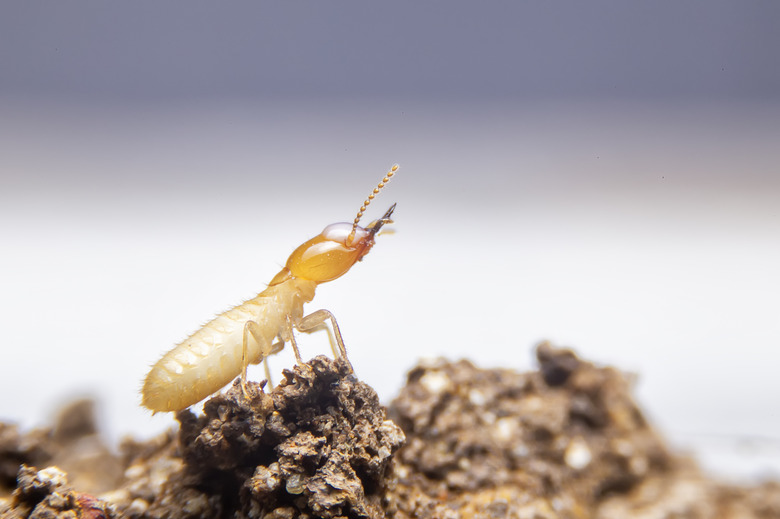Chemicals Used To Kill Termites
We may receive a commission on purchases made from links.
No homeowner wants to deal with invasive termites, which can cause considerable damage to your home. Termite colonies are difficult to identify because their subterranean behavior keeps them hidden for the most part and shows few above-ground signs of their presence. To fight back against termite infestations, known or suspected, several chemical pesticides are available and are specifically designed to kill termites. The methods of application, as well as active ingredients and chemical reactions that kill termites, vary significantly.
Fipronil to Disrupt Nervous System
Fipronil to Disrupt Nervous System
Fipronil is the active ingredient in many liquid termite control products — the most common is Termidor. Fipronil is specially designed by biochemists to disrupt the central nervous system of termites that come in contact with the chemical; fipronil in high concentrations kills termites on contact. It's highly effective as a barrier treatment both during known infestations and as a preventive treatment around homes. Fipronil is dissolved in water and applied underground around the foundations of homes to create a protective barrier against termites. It has low to medium toxicity effects on humans.
Imidacloprid to Kill Termite Colonies
Imidacloprid to Kill Termite Colonies
Imidacloprid is a synthetic insecticide derived from nicotine and is the active ingredient of the underground termite chemical Premis. Imidacloprid is a deadly chemical that works by ingestion or contact. The chemical binds to nicotinic receptors in the nervous system and causes continual signaling of those receptors, preventing the chemical from being broken down by the host's immune system. The binding of imidacloprid is an irreversible, fatal process for termites.
The chemical is slow-acting, which allows termites who come in contact with low concentrations to transfer the toxin to other termites. If the infected termites find their way back to the queen, imidacloprid will kill the entire colony as well as individuals causing damage to a home.
Hexaflumuron as a Growth Inhibitor
Hexaflumuron as a Growth Inhibitor
Hexaflumuron is a termiticide commonly used by pest control professionals in termite baiting systems such as Sentricon. As opposed to liquid chemicals, hexaflumuron is a slow-acting insect growth inhibitor that disrupts a termite's ability to shed its exoskeleton and continue to grow. Hexaflumuron is specifically designed for termite baiting systems and exploits the social behavior of termite colonies.
When termites find the baiting stations, they leave chemical trails that inform other termites where the food source is located. As termites feed on hexaflumuron, they're exposed to the chemical and carry it with them back to the colony, spreading the chemical to other termites they come in contact with. Once enough termites have fed on the chemical bait, the concentrations of hexaflumuron in the colony will be high enough that the queen will also receive the chemical, which sterilizes the queen, and the colony will die.
Because of its passive nature, hexaflumuron is considered a reduced-risk pesticide by the U.S. Environmental Protection Agency. This designation means that it poses a lower risk to humans and the environment compared to alternative products.
Bifenthrin to Disrupt Nerve Function
Bifenthrin to Disrupt Nerve Function
Pyrethroid, which comes from chrysanthemum flowers, is the active ingredient in bifenthrin. This synthetic pesticide interrupts nerve functioning, which paralyzes the termites and causes them to die due to suffocation. Pest control professionals mix it with water and apply it around the perimeter of your home. It can be applied at different concentrations, which affects the length of protection provided by the chemical. This chemical is considered to have medium to high toxicity for humans.
